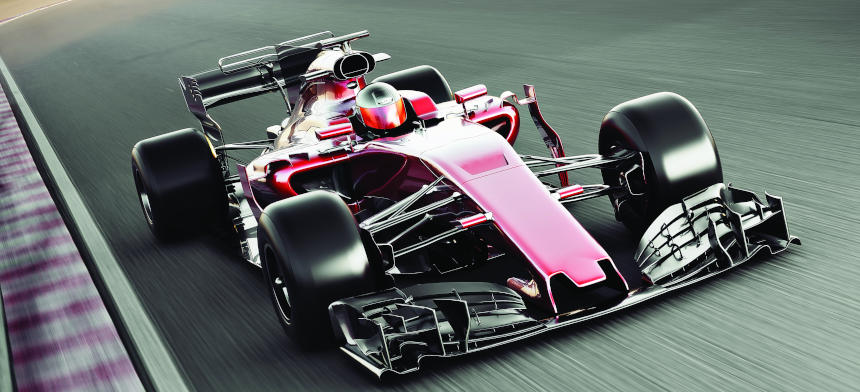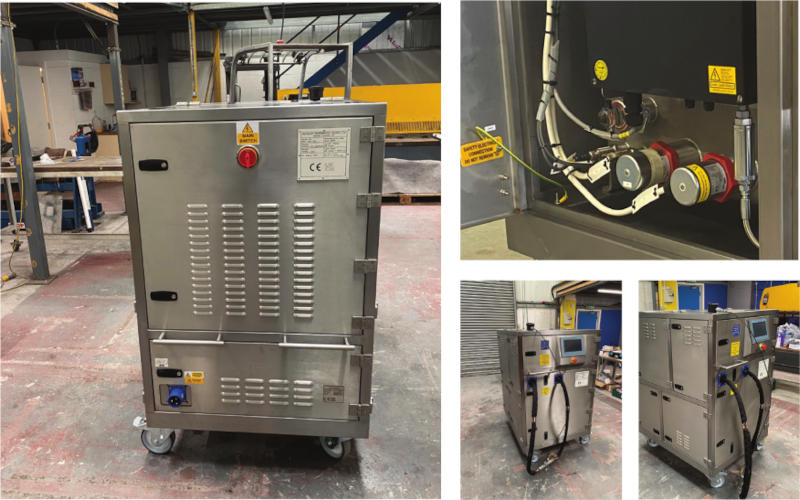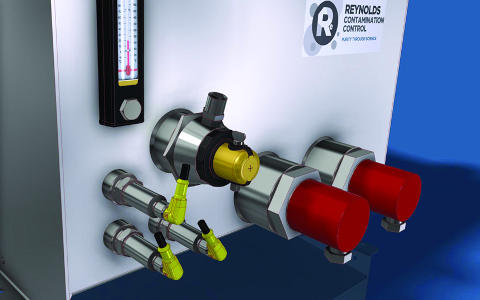POD RACING: Fluid Monitoring in Formula One™
While sending oil or fluid samples off to the lab is a great way to verify the cleanliness of your fluids and the health of your equipment, the process takes time. Online particle counting is faster, but you may have to trade a certain amount of accuracy for that speed. Cost also will play a role in making the best decision for your needs and application.
But for Wayne Hubball, Technical Director at Reynolds Contamination Control (RCC), it’s a combination of technological tools and human inspection that delivers the best results for his clients, and he’s come a long way from the early days in the industry.
 “My first particle counter 20 years ago was worth more than my car,” Wayne said, laughing.
“My first particle counter 20 years ago was worth more than my car,” Wayne said, laughing.
We spoke with Hubball about a system that has brought powerful insights and a high level of cleanliness to mining operations, fuel providers, and even Formula One™ racing teams. We also covered the role that traditional oil or fluid sampling plays in the process and how RCC developed a mobile flushing package that brings it all together.
Purity Through Science
While Reynolds Contamination Control offers flushing and fluid monitoring for a range of fuel and fluid systems, it was their experience developing tailor-made sensor and flushing systems for specialized applications that caught the eye of their most speed-obsessed customers.
One of the core elements of their solution is called The Link, a real-time fluid condition monitoring system that allows users to have an instant, quite holistic picture of their assets, including fuels, coolants, oils or other fluids they depend on.
Because the system is mobile, battery-powered, and can handle a range of different fluids and applications, it was the perfect fit for a type of customer that demands performance, reliability and cleanliness at the highest levels - Formula One racing teams.
Speed, Reliability, Accuracy
If you’re familiar with Formula One, you probably already know that the profitability of a racing team and the reliability of their race cars go hand in hand. Each “Constructor” (the teams who design, build and race two new cars each year) has a budget cap of $140 million to create their cars. Estimates for the total revenue generated by the sport for 2021 are around $2.14 billion.
Much like equipment downtime in a plant or mine site, if a Formula One car is not performing properly, the team stands to lose a huge amount of money in a very small amount of time - the difference between finishing 1st versus finishing 2nd in a Grand Prix might be a tenth of a second that costs the team $10 million or more in lost earnings, depending on overall standings. Every aspect of the car must be at peak performance on race day - but even the fastest car in the world will not win championships if it is not highly reliable. But how do fluid monitoring and flushing fit into that picture?
 Formula One cars don’t just have an internal combustion engine; they have what is known as a Power Unit or PU. The PU brings together both internal combustion power and electrical power to give cars the ability to “harvest” energy and store it in the Energy Storage System (ESS) strategically during one lap to then release it in another, giving the car an electrical speed boost on command.
Formula One cars don’t just have an internal combustion engine; they have what is known as a Power Unit or PU. The PU brings together both internal combustion power and electrical power to give cars the ability to “harvest” energy and store it in the Energy Storage System (ESS) strategically during one lap to then release it in another, giving the car an electrical speed boost on command.
This system uses a lithium-ion battery that must perform under extreme conditions - not just at high speeds but in drastically different environments around the world. One week a Grand Prix might be cool and rainy in Canada, with another race in the desert environment of Saudi Arabia two weeks later.
 In both environments, the battery has to be kept at the optimal temperature through cycles of charging and discharging during a race. But one racing team was struggling with a chronic fluid contamination problem, and they were spending over two hours flushing and filtering the system only to fail to achieve the Recommended Cleanliness Level (RCL) time and again, so they called Wayne.
In both environments, the battery has to be kept at the optimal temperature through cycles of charging and discharging during a race. But one racing team was struggling with a chronic fluid contamination problem, and they were spending over two hours flushing and filtering the system only to fail to achieve the Recommended Cleanliness Level (RCL) time and again, so they called Wayne.
Contamination Solution
RCC’s v fit the bill perfectly, and this particular rig was outfitted with 23 different sensors, monitoring temperature, fluid level, flow, filter differential, pressure, particle counts, relative humidity and water content. Its ability to both monitor and clean the temperature control fluid (sometimes a water/glycol mixture, but in this case a fully synthetic PAO) while outputting detailed data to a cloud dashboard was just what the team needed. They also needed help selecting the right Beta-rated filters to properly remove the fluid-borne contaminants to cut down on flushing time between races.
During flushing, RCC made sure that the flow rate gave a Reynolds number greater than 4100 to achieve turbulent flow without causing a pressure increase above 1 bar. Temperature was also a concern, needing to maintain under 48 C. The recommended cleanliness level target was SAE AS 4059 REV F cpc 6. The cpc in this code stands for Cumulative Particle Count.
During the filterability trial, RCC installed two offline filter housings fitted with 3-micron media on the flush line and return line combined with a breather on the reservoir. When the first sample was taken from the battery pre-filter’s return line, a cleanliness level of SAE AS4059F cpc 11 was found.
After flushing, onboard particle counters read a final cleanliness level of SAE AS4059F cpc 2, and this result was achieved in a flushing cycle averaging 24 minutes rather than 2 hours. In an environment where time is critical, both on and off the race track, these results were just what the team needed.
But, as mentioned above, it is always a good idea to verify onsite oil or fluid analysis results through sampling and lab testing. Fortunately, Wayne had that covered as well with the help of a Luneta Condition Monitoring Pod (CMP) installed on the flushing rig’s reservoir.
Trust, But Verify
Making it fast and simple to inspect fluid visually and take reliably clean samples day in and day out helps encourage good practices, allowing users to verify onsite analysis and catch obvious problems visually before they lead to failure. Hubball says it fits right in with his vision for RCC’s systems.
“It just makes life so much easier,” Hubball said, “What’s in the reservoir? What’s going on visually? Bringing in the Condition Monitoring Pod was really about the ease-of-use for us and how we integrate it into the day-to-day process of taking verification samples. We wanted to provide clients a full package solution, and the Luneta CMP helps us do that.”
Anyone who is responsible for the reliability or maintenance of a critical machine (even one that does not travel at triple-digit speeds around hairpin turns) can glean a useful lesson from the world of Formula One: Even when speed is an absolute priority, and you have all the cutting-edge condition monitoring technology you could need, simple visual inspections and laboratory results still play a vital role in any serious reliability or maintenance effort.
Hydrodynamics History
 If you’re a regular reader of Machinery Lubrication, you can probably spot that Reynolds Contamination Control takes its company name from a hero of hydrodynamics, Osborne Reynolds.
If you’re a regular reader of Machinery Lubrication, you can probably spot that Reynolds Contamination Control takes its company name from a hero of hydrodynamics, Osborne Reynolds.
Born in Belfast, Ireland, Osborne Reynolds (August 23, 1842 - February 21, 1912) was a British fluid dynamics engineer who studied conditions in which the flow of fluid in pipes transitioned from laminar to turbulent. The result of Reynolds' studies was a dimensionless number (Reynolds Number) representing the ratio of inertial forces to viscous forces. Flow typically changes from laminar to turbulent between Reynolds numbers 2,000 and 4,000. Turbulent flow, with a high Reynolds number, sharply improves the effectiveness of flushing tasks.
Condition Monitoring Pod (CMP)
 Using a sight glass like the Luneta CMP gives operators and technicians a visible inspection window into the condition of lubricants and machines. Users can quickly inspect oil level, color and clarity, oil aeration and foaming corrosion, varnish, wear debris and other key inspections. Adding a sight glass to your equipment can provide valuable insights without adding significant costs, improving your chances of identifying root causes and symptoms of failure before they lead to unplanned downtime.
Using a sight glass like the Luneta CMP gives operators and technicians a visible inspection window into the condition of lubricants and machines. Users can quickly inspect oil level, color and clarity, oil aeration and foaming corrosion, varnish, wear debris and other key inspections. Adding a sight glass to your equipment can provide valuable insights without adding significant costs, improving your chances of identifying root causes and symptoms of failure before they lead to unplanned downtime.
